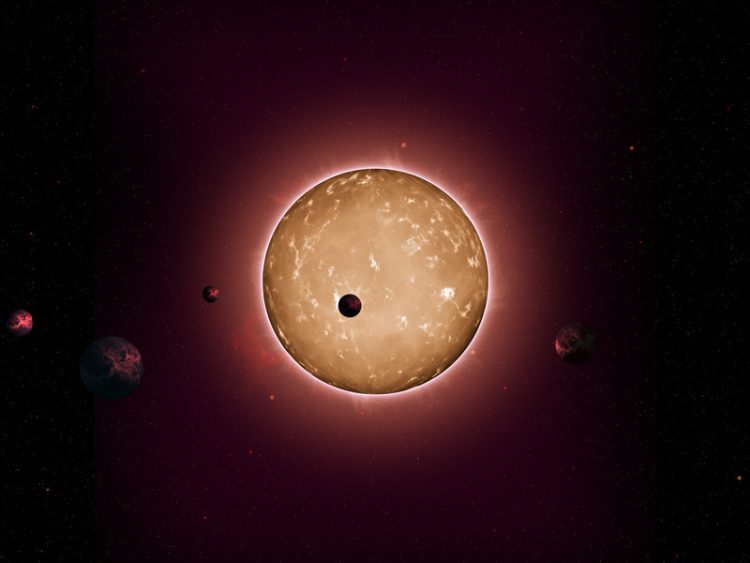Kepler-444 has ancient planetary system

Planetary system at a remote sun: five Earth-sized planets orbit the star Kepler-444 in the constellation Cygnus. With an age of 11.2 billion years, this is the oldest known system of Earth-sized planets. © Tiago Campante / Peter Devine
A group of scientists led by the University of Birmingham has discovered the oldest known solar system containing Earth-sized planets. Five of these comparatively small planets orbit the star Kepler-444, whose birth dates back about 11.2 billion years.
The new findings are based on data from NASA’s Kepler Space Observatory. They suggest that habitable worlds might have existed earlier in the Universe than previously thought. Researchers from the Max Planck Institute for Solar System Research and the University of Göttingen in Germany contributed to this groundbreaking study.
The planetary system around the star Kepler-444 appears like a distant version of our own inner solar system: Even though not four, but five small planets orbit the host star, their sizes all lie between those of Mercury and Venus.
The exoplanets orbit Kepler-444 in less than ten days or, equivalently, at less than one-tenth Earth’s distance from the Sun. The age of the system is a surprise: with 11.2 billion years, it is almost two and a half times as old as our solar system. So far, no other system of comparable age is known to host Earth-sized planets.
The team carried out the research using asteroseismology: with the help of the Kepler Space Observatory the researchers listened to the natural resonances of the host star which are caused by sound waves trapped within it. “These oscillations lead to miniscule variations in its brightness which allow us to measure its diameter, mass, and age”, says Saskia Hekker from the Max Planck Institute for Solar System Research.
The planets were detected from the dimming that occurs when they passed in front of the star. This fractional fading in the intensity of the light received from the star enables scientists to accurately measure the sizes of the planets relative to the size of the star.
The Kepler Space Observatory has been searching for exoplanets since 2009. Over a period of four years it repeatedly turned its gaze to star Kepler-444. “Long, uninterrupted observations are necessary to observe the weak pulsations. Only with the exquisite, high quality data from the Kepler mission has this been possible”, explains Dr. Timothy White from the University of Göttingen.
“There are far-reaching implications from this discovery”, says Tiago Campante from the University of Birmingham, who led the research. It proves that Earth-sized planets have formed throughout most of the Universe’s 13.8-billion-year history. Hekker clarifies that “We therefore think it is possible that worlds which could support life may have existed even in this early phase of the Universe’s evolution.
Since the beginning of this year, Saskia Hekker heads the new Max Planck Research Group “Stellar Ages and Galactic Evolution” at the MPS. After receiving her doctorate in 2007 at the University of Leiden in the Netherlands, she did research at the Royal Observatory of Belgium and at the University of Birmingham in England. In 2011 she received the prestigious Veni Fellowship of the Netherlands Organization for Scientific Research to continue her work at the Astronomical Institute “Anton Pannenkoek” of the University of Amsterdam. Since 2013 Hekker’s scientific home is the MPS in Göttingen where she was awarded a Starting Grant of the European Research Council.
Contact
Dr. Birgit Krummheuer
Press Officer
Max Planck Institute for Solar System Research, Göttingen
Phone: +49 551 384979-462
Fax: +49 551 384979-240
Email: Krummheuer@mps.mpg.de
Dr. Saskia Hekker
Max Planck Institute for Solar System Research, Göttingen
Phone: +49 551 384979-257
Email: Hekker@mps.mpg.de
Dr. Timothy White
Institut für Astrophysik, Universität Göttingen
Phone: +49 551 3913-811
Email: twhite@astro.physik.uni-goettingen.de
Original publication
T.L. Campante et al.
An ancient extrasolar system with five sub-Earth-size planets
Astrophysical Journal, 27 January 2015
Media Contact
More Information:
http://www.mpg.de/8916263/exoplanets-kepler-444All latest news from the category: Physics and Astronomy
This area deals with the fundamental laws and building blocks of nature and how they interact, the properties and the behavior of matter, and research into space and time and their structures.
innovations-report provides in-depth reports and articles on subjects such as astrophysics, laser technologies, nuclear, quantum, particle and solid-state physics, nanotechnologies, planetary research and findings (Mars, Venus) and developments related to the Hubble Telescope.
Newest articles

A new puzzle piece for string theory research
Dr. Ksenia Fedosova from the Cluster of Excellence Mathematics Münster, along with an international research team, has proven a conjecture in string theory that physicists had proposed regarding certain equations….

Climate change can cause stress in herring larvae
The occurrence of multiple stressors undermines the acclimatisation strategies of juvenile herring: If larvae are exposed to several stress factors at the same time, their ability to respond to these…

Making high-yielding rice affordable and sustainable
Plant biologists show how two genes work together to trigger embryo formation in rice. Rice is a staple food crop for more than half the world’s population, but most farmers…



